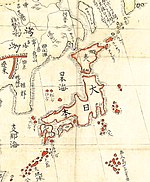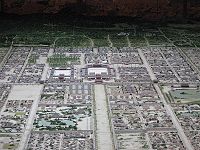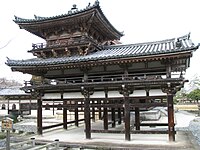Heian period

| History of Japan |
|---|
 |
The Heian period (平安時代, Heian jidai) is a time in the Japanese history from 794 to 1185. This grouping of years is named after city of Heian-kyō, which is the early name of present day Kyoto.[1]
History
[change | change source]The Heian period began in 794 when the capital of Japan was moved to Heian-kyō. It lasted until 1185, which is the beginning of the Kamakura period.[2]
In this period Kyoto was the center of Japanese culture. It was also in this period that the first known novel was published. The author was a woman. Poetry was very popular in Heian-kyo at the time.
Timeline
[change | change source]- 794: Emperor Kammu moves the capital to Heian-kyō.[3]
- 804: Saichō (also known as Dengyo Daishi) establishes the Tendai Buddhist sect in Japan.[4]
- 806: Kūkai (also known as Kōbō-Daishi) establishes the Shingon Bhuddist sect in Japan[5]
- 858: Reign of Emperor Seiwa begins; the power of the Fujiwara clan expands[6]
- 895: Sugawara Michizane persuades Emperor Uda to suspend Imperial embassies to China.[7]
- 1053: Byōdō-in temple near Kyōto is completed[8]
- 1087: Emperor Shirakawa abdicates and becomes a Buddhist monk, the beginning of the Insei system of Imperial government[9]
- 1185: Death of Emperor Antoku; Taira clan is defeated in the Gempei War[10]
Gallery
[change | change source]- Model of ancient Kyoto with Imperial Palace
- South wing of the Phoenix Hall in the Byodo-In temple in Uji
Related pages
[change | change source]References
[change | change source]- ↑ Library of Congress Country Studies, Japan,"Nara and Heian Periods". Retrieved 2011-10-20.
- ↑ Nussbaum, Louis-Frédéric. (2002). "Heian-jidai" in Japan Encyclopedia, p. 302.
- ↑ Brown, Delmer M. (1979). Gukanshō, pp. 277-279.
- ↑ History of Tendai Buddhism Archived 2011-10-16 at the Wayback Machine. Retrieved 2011-10-20.
- ↑ Koyosan Shingon Buddhism Archived 2011-10-02 at the Wayback Machine, Kobo Daishi Archived 2012-02-16 at the Wayback Machine. Retrieved 2011-10-20.
- ↑ Titsingh, Isaac. (1834). Annales des empereurs du japon, pp. 115-121; Brown, pp. 286-288; Varley, H. Paul. (1980). Jinnō Shōtōki, pp. 166-17.
- ↑ Kitagawa, Hiroshi et al. (1975). The Tale of the Heike, p. 222.
- ↑ Asian Historical Architecture, Byōdō-in. Retrieved 2011-10-20.
- ↑ Titsingh, p. 171; Brown, p. 316; Varley, p. 202.
- ↑ Kitagawa, p. 787; Titsingh, pp. 211-212.
Other websites
[change | change source]![]() Media related to Heian period at Wikimedia Commons
Media related to Heian period at Wikimedia Commons
- Metropolitan Museum of Art, Heian Period (794–1185)
- British Museum, Heian period (AD 794-1185)
- Japan-guide.com, Nara and Heian Periods (710-1185)

